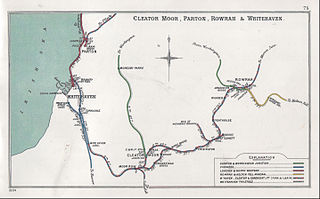The Maryport & Carlisle Railway (M&CR) was an English railway company formed in 1836 which built and operated a small but eventually highly profitable railway to connect Maryport and Carlisle in Cumberland, England. There were many small collieries in the area and efficient access to the harbour at Maryport was important.

The Cumbrian Coast line is a rail route in North West England, running from Carlisle to Barrow-in-Furness via Workington and Whitehaven. The line forms part of Network Rail route NW 4033, which continues via Ulverston and Grange-over-Sands to Carnforth, where it connects with the West Coast Main Line.

Workington railway station is a railway station serving the coastal town of Workington in Cumbria, England. It is on the Cumbrian Coast Line, which runs between Carlisle and Barrow-in-Furness. It is owned by Network Rail and managed by Northern Trains.

Keswick railway station was on the Cockermouth, Keswick and Penrith Railway between Penrith and Cockermouth in Cumberland, England. It served the town of Keswick and accommodated the offices of the Cockermouth, Keswick and Penrith Railway Company.

Workington Bridge railway station was situated at the northern end of Workington Bridge next to the River Derwent, and was originally served by the Cockermouth and Workington Railway, later absorbed by the London and North Western Railway; the road at the north end of the bridge having to be raised to allow the railway to pass under it. It served eastern Workington, Cumberland, England.
The Cockermouth & Workington Railway was an English railway company which built and operated a railway between the Cumberland towns of Workington and Cockermouth. The railway opened for service in 1847, and ran from the Whitehaven Junction Railway station at Workington to a station at Cockermouth near the bridge over the Derwent. A single-tracked line of eight and a half miles length, its revenue came largely from the transport of coal from the pits of the lower Derwent valley to the port at Workington for shipment by sea. The Marron extension of the Whitehaven, Cleator and Egremont Railway and the Derwent Branch of the Maryport and Carlisle Railway were both constructed to link with the C&WR and together give an alternative route for the northward movement of haematite ore from the Cumberland ore-field. The completion of the Cockermouth, Keswick and Penrith Railway made the C&WR part of a continuous through route between South Durham and the Cumberland orefield. These developments both improved the potential profitability of the C&WR, and made control of it important to bigger companies wishing to maximise the iron-ore traffic over their lines: the C&WR was absorbed by the London and North Western Railway in 1866.
The Whitehaven, Cleator and Egremont Railway was an English railway company which built and operated a standard gauge railway in Cumberland, England intended to open up the hematite orefield to the south-east of Whitehaven. It opened for goods traffic in 1855 and for passenger traffic in 1857.

Cleator Moor West railway station was opened as "Cleator Moor" by the Cleator and Workington Junction Railway (C&WJR) in 1879. It served the growing industrial town of Cleator Moor, Cumbria, England.

Great Broughton railway station briefly served the village of Great Broughton, near Cockermouth in Cumberland, England.

Rowrah railway station was built by the Whitehaven, Cleator and Egremont Railway. It served the village of Rowrah, Cumbria, England.

Bridgefoot railway station was built by the Whitehaven, Cleator and Egremont Railway. It served the village of Bridgefoot, Cumbria, England.

Branthwaite railway station was built by the Whitehaven, Cleator and Egremont Railway. It served the village of Branthwaite, Cumbria, England.
Ullock railway station was built by the Whitehaven, Cleator and Egremont Railway. It served the village of Ullock, Cumbria, England.
Lamplugh railway station was built by the Whitehaven, Cleator and Egremont Railway. It served the scattered community of Lamplugh, Cumbria, England.

Winder railway station was built by the Whitehaven, Cleator and Egremont Railway. It served the village of Winder, Frizington, Cumbria, England.

Yeathouse railway station was a later addition to the Whitehaven, Cleator and Egremont Railway. It served the communities of Yeathouse and Eskett, near Frizington, Cumbria, England.

Frizington railway station was built by the Whitehaven, Cleator and Egremont Railway. It served the industrial Parkside area of Frizington, Cumbria, England.
Egremont railway station was built by the Whitehaven, Cleator and Egremont Railway as the first southern terminus of what would become the Moor Row to Sellafield branch. In 1878 the company was bought out by the LNWR and Furness Railway who operated the line jointly until grouping in 1923.

Linefoot railway station, sometimes referred to as Linefoot Junction and sometimes as Linefoot Goods, briefly served the scattered community around the crossroads at Linefoot, near Cockermouth in Cumberland, England.
National Cycle Network (NCN) Route 71 is a Sustrans National Route that runs from Whitehaven and Workington on the Cumbrian coast to Kirby Knowle in North Yorkshire to join NCN Route 65. The route is fully open and signed in both directions.











